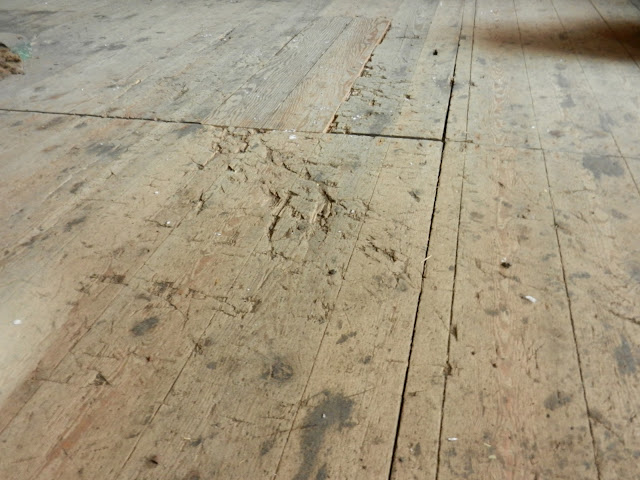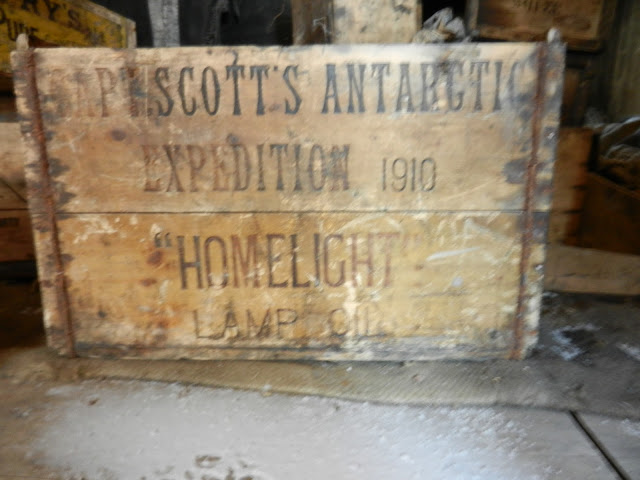Robert Scott's Discovery Hut (1902)
(Mildly graphic images)
Built from mid-February to May,1902, the hut was to have been quarters for about a dozen men of Scott's Antarctic landing party, whose mission was to explore what is now the Ross Island area, conduct scientific studies, and determine a possible land route to the South Pole, if one indeed existed. Scott changed his mind and, allowing their ship
The Discovery to become locked in sea ice, determined the ship and its crew would all remain through the Antarctic winter - the small bay being named Winter Quarters Bay.
The hut was a pre-fabricated design from Australia, made of jarrah wood. Designed to remain cool through the Outback summers, the men from Scott's party (and those expeditions that followed) found the hut unbearably cold and nearly impossible to heat. Often colder inside the hut then out, the men of the
Discovery expedition prefered to remain on their ice-moored ship, and the hut was relegated to storage, scientific studies, and even a venue for a couple of plays the men performed for entertainment. It isn't particularly known why this design was chosen for a shelter in an environment where retaining warmth is a premium, but I'd guess it may have been for its proven ruggedness and ease of construction.
The hut was used by the
Discovery expedition from 1902-1904; Ernest Shackleton's
Nimrod expedition from 1907-1909; Scott, again, on his ill-fated
Terra Nova expedition (1910-1913) in his fatal attempt to be the first to reach the South Pole; and, finally, again by Shackleton's Ross Sea crew during his failed attempt to traverse the Antarctica continent via the South Pole on his
Aurora expedition between 1915-1917. Artifacts from all expeditions still remain in the hut.
Two other huts erected by Scott and Shackleton remain on Ross Island at Cape Evans and Cape Royds, respectively; being the furthest-most south of the three huts, however,
Discovery hut inevitably became an important staging depot for the many sledging ventures, and a grim shelter for dying men desperate to reach its safety.
I've taken a certification course from the National Science Foundation to be a tour guide for the historic huts of Ross Island but, because of the thin sea ice this year, access to Cape Evans and Cape Royds north of McMurdo is limited to helicopter, and I don't anticipate being able to visit the other two huts. Were these huts to be in the States, they would be behind glass or in the Smithsonian. Amazingly, all the artifacts in this, and the other huts, are authentic - there are no replicas or recreations. Curators from New Zealand, Australia, the U.S., Canada, Britain, and Germany are currently cataloging the contents of each of the huts and individually preserving them. Using authentic photographs and precise measurements, the items are carefully returned to their original positions as the men had left them upon their departure from the island.
 |
| Discovery Hut, with Vince's Cross overlooking. |
 |
| The pole in front of the hut was used for signalling to the Discovery moored in the sea ice. |
 |
| Crates of stores were stacked along two sides of the verana to enclose it, creating a stable for 5 ponies. |
 |
| A bundle of canvas awning, or perhaps sails, from the Discovery. No one is quite certain and it has laid undisturbed. On top lies the remains of a seal - certain to be butchered for its meat and fuel. |
 |
| Still seen are its ivory teeth and whiskers. |
 |
| A pre-fabricated design, one can still see the color-coded alignment markings from the manufacturer. |
 |
| The dim interior. |
 |
| Nearly impossible to heat, frost readily forms on the hut's ceiling. |
 |
| Seal carcasses. A mainstay for food and fuel for the starving men of later expeditions. |
 |
| Evidence of the butchering on the hut floor. |
 |
| Food stores from both Scott and Shackleton's expeditions. |
 |
| Lamp oil for Scott's Terra Nova venture to The Pole. |
 |
| Fuel cans from Scott's first expedition. Their leather gaskets shrunk in the dessicating Antarctica air and the white gas quickly evaoporated. Upon their return from a sledging expedition south, the men found their cans dry and dispaired over the loss of their fuel - critical for their warmth, light, and life. |
 |
| With no fuel for their lamps and stove, the men resorted to burning seal blubber. The heavy smoke would fill the hut, coating everything (and everyone) with thick, greasy soot. Shown here is the blubber stove, a final meal of seal meat in the skillet, and a hatchet coated in gore. |
 |
| Improvements to the stove later helped to reduce drafts and sooting. |
 |
| Black evidence of grime and soot from the blubber stove. Men from Shackelton's Aurora expedition, exhausted and starving from their attempts to lay food caches for Shackleton's own failed Antarctic crossing, stumbled into Discovery hut sick with scurvy and dying from exposure. They found the hut's interior filled with ice and snow, blown in from an open window. The 5 men carved out a small clearing in which to eat and sleep, surviving three months of the Antarctic winter on seal meat and blubber. Tragically, they never saw this stack of provisions buried under the snow, only five feet from where they made their clearing. |
 |
| A drying rack for fur boots, wool socks, and mittens. |
 |
| Rough hewn trousers from heavy sail canvas, bearing the signs of wear from the mens' heavy sledging. |
 |
| On the far right of the shelves, the ingenious Primus stove (upon which modern camp stoves are still modeled) and, below it on the bottom shelf, a hand-made tin blubber lamp. |
 |
| In an attempt to create some insulation, heavy canvas awnings were hung on the north side of the hut. |
 |
| The Primus stove. The men had such confidence in the reliability of their stove, Scott and his small group carried only one with them on their trek to the Pole. If it were to fail, the men would have no means to melt snow for water. |
 |
| Blubber fuel. |
 |
| My camera had difficulty compensating in the dim light and shadows inside the hut, but I was very pleased with the grainy texture of this picture. |
 |
| Mutton and penguin carcasses. |
 |
| Broom and a rusted shovel. |
 |
| A saw and a sledging strap. The men would drag heavy sledges laden with supplies on their many expeditions, at times in waist-deep snow. Roald Amundsen, a member of Victor Borckrevink's Southern Cross expedition, described sledging as the cruelest form of human punishment and swore to never again pull a sledge. On his historic trek to the South Pole in December, 1911, Amundsen and his team used sled dogs and skis. |
 |
| Vince's Cross. In the early winter of 1902, a team of twelve men set out to cross Ross Island in an effort to leave a message on the seaward side of the island for their relief ships as to the mens' whereabouts (the message was to have been placed in a tin fuel can and mounted on a pole on the beach). Having difficulty in traversing the rocky volcanic terrain, the men decided to split up, with 4 continuing on to Cape Crozier to place the message, and the remaining 8 returning back to their ship. Caught in a blizzard the 8 men decided to press on towards the ship. Vince was wearing finnesko boots (Finnish boots made of reindeer skins, what we might think of as boot liners), which were warmer than the other mens' leather boots, but they offered little traction. Vince was blown off the steep, rocky cliffs and was unable to break his slide into the sea; his body was never found. The cross was erected in 1904 upon the expedition's departure from Ross Island. |






































No comments:
Post a Comment